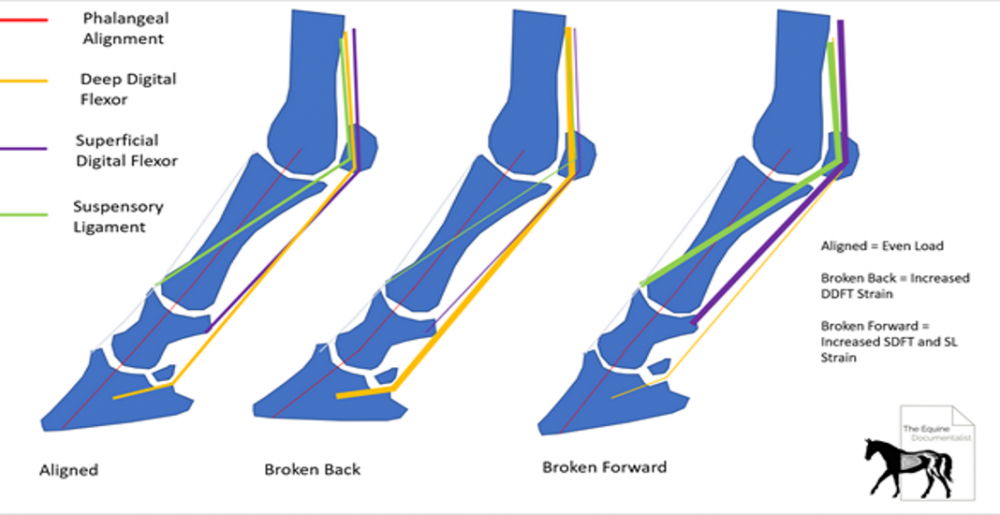
The Effect of digit alignment on the soft tissue structures of the digit
The Effect of digit alignment on the soft tissue structures of the digit by Yogi Sharp - the equinedocumentalist

What effect does changing the angle of the hoof and therefore phalangeal alignment have on the soft tissue structures of the digit?
It is often questioned as to whether artificially aligning the hoof Pastern axis over loads the suspensory ligament and/or superficial digital flexor tendon and whether therefore it is not good practice.
There have been studies in favour of artificial elevation and some against.
Hinterhofer et al. (2001) stated there were smaller deformations of the hoof with a 5 degree hoof angle increase. But acknowledged the risk of further crushing to the heels supported by the finding of increased load on the heels with wedges (Wilson et al. 1998).
Thompson et al. (1993) found that the Deep digital flexor tendon (DDFT) strain decreased with elevation and that the superficial digital flexor tendon (SDFT) and suspensory ligament (SL) strain were NOT affected, however strain on the extensor branch of the SL increased rapidly. Riemersma et al. (1996) also measured an increase strain in the SL.
Other studies have measured increased intra articular pressure with elevation, showing that joints and ligaments are also affected by these changes in angle.
With these findings it’s understandable why the increased load on the SL and other structures is often a concern. However, what remains unclear from all of these studies is what the phalangeal alignment was at the time of an increase or reduction of hoof angle. Also, what hasn’t been quantified is what the strains are of those structures in an ideal digit.
Many studies have linked a broken back alignment with increased load on the DDFT.
Broken back HPA (BBHPA), has been shown to predispose the horse to navicular syndrome. Waguespack and Hanson (2010) outlined the biomechanical considerations of a BBHPA and stated that the primary source of pressure on the navicular bone (NB) is compression from the deep digital flexor tendon (DDFT), Ruff et al. (2016) expanded on this, expressing the increased compressive force on the NB from the DDFT in conformations exhibiting increased dorsiflexion, this was supported by Uhl et al (2018) which stated conformations described by Ruff et al. (2016) as being mechanically predisposed to navicular and that DDFT lesions corresponded with areas of increased load. Many other papers have expressed the importance of a good HPA, (Witte (2014), Zani et al. (2015), Logie (2017), Turner (2020), Brown (2020)), outlining its importance in optimal performance and the predispositions of a BBHPA
If you raise the heels in a broken alignment, perhaps you will get an increased strain reading in the SL or SDFT, but the question is, have you over loaded those structures or returned to a more even strain share of all the relevant structures, especially in the light of all the papers just stated.
More research needs to be done to quantify what appertains to ideal strain share and whether that is obtained at aligned. But my hypothesis is that ideal strain share would correlate closely with ideal alignment.
The title image shows an illustration of that theory. Aligned has ideal strain share of the 3 structures. Broken back, increased strain of the DDFT and broken forward has increased strain of the SDFT and SL. Increased strain shown by thicker lines.
For more information on alignment feel free to watch and read at these links.
.
.